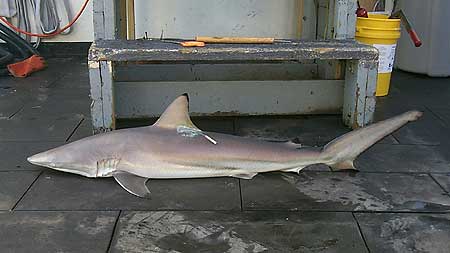
|
|
|
|
|
|
Shark Info (11-04-2002) |
Author |
|
Intro: |
Shark Info |
|
Main article: |
Dr. A. J. Godknecht, Dr. G. D. Guex |
|
Article 1: |
Shark Info |
|
Article 2: |
Pathological changes caused by fish hooks on the blue shark (Prionace glauca) |
Shark Info |
Article 3: |
Shark Info |
|
Fact Sheet: |
Shark Info |
|
Fact Sheet: Spinner Shark
Biology of the spinner shark (Carcharhinus brevipinna)Spinner sharks are a fast-swimming species of shark which often jumps out of the water (hence the name!). The reason for their “spinning” or spiral motion is the way in which they catch their prey. Climbing quickly within a shoal of fish, they snap on all sides while turning. Then they leap through the water’s surface, making no attempt to slow down before reaching the top. DescriptionSpinner sharks are large and slender and have a pointed snout. The first dorsal fin is relatively small and begins at the same height as the end of the pectoral fin or slightly behind it. Spinner sharks have no interdorsal ridge. ColoringTheir back is gray-bronze and their belly is white, and they have a thin white band along their flanks. Very noticeable are the black tips on both dorsal fins, pectoral and anal fins, as well as the lower lobus of the tail fin. Individuals smaller than 70 cm have no dark markings. Distribution
Western Atlantic: North Carolina down to Florida, the Bahamas, Cuba
and the northern Gulf of Mexico (probably missing in the Caribbean),
Brazil. SizeTheir average length is approximately 195 cm at a weight of 56 kg. The longest spinner shark found to date measured 278 cm. DietThey feed mainly on fish, preferring swarm fish such as sardines or herring. However, their food spectrum is very wide and also include tuna, grunt fish, lizard fish, etc., as well as mollusks, small sharks and rays. ReproductionSpinner sharks are viviparous and have a yolk sac placenta. They bear between 3 and 15 pups which measure between 60 and 75 cm at birth. Their gestation period is 12 to 15 months and the time of birth varies depending on the location: the summer months for animals in Senegal, Spring and early Summer in Florida and the Gulf of Mexico. The young pups are born in coastal regions and grow quickly. Similar SpeciesThe spinner shark resembles several other shark species which are mostly only identifiable by specialists. The striking black coloring of the anal fins is, however, one clear characteristic recognizable in larger animals. This species is usually mistaken for the blacktip shark (Carcharhinus limbatus) which, however, contrary to the spinner sharks has a white anal fin with no black tip. Encounters with HumansThere have been no reports on accidents with spinner sharks. EndangermentStatus unknown. May be published only by indicating the source: Shark Info |
|
|
|
|
|
|||||
